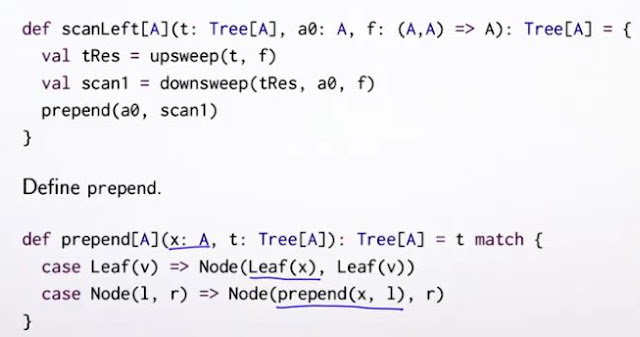Scan Left (Prefix sum problem)
xs.scan left(x)(f) 接受一個initial value x,回傳一個新的list ys( x, y1=f(x, xs[0]), y2=f(y1,xs[1]), f(y2,xs[2]), ... )假設f 是associative。
sequential版本如下:
parallel版本:
首先output array中的每個element其實都有獨立的計算可能,不需要真的依賴前一個element被算完才能計算,所以parallelism是可以實現的,例如:
out(0) = a0
out(1) = a0+inp(0)
out(2) = a0+inp(0)+input(1)
.
.
.
這個的問題在於每個out(i)都重覆計算了out(i-1)的動作,這是parallelization的overhead,但是parallism的效益會補償這個損失。
假設我們要用之前提過的parallel版本的array segment reduce和 array segment map來implement parallel scan的話,該怎麼做呢?
注意mapSeg中的fi接受index參數和input array value參數。
這邊有點複雜:
首先mapSeg把input array parallel的分成一半,再一半,一直下去,直到不能分(array size <threshold)之後,就apply sequential map function,此時fi 就會被呼叫在那一段base case的array上,注意fi 接受參數(array position index, pointer to array position)。
所以reduceSeg1就會作用在array區間0 ~ i (exclusive)的array上,把0~i都根據f和initial value a0 reduce成某一個數值。這邊應該要叫做fold才對吧,fold才有initial value,reduce是沒有的,實在很混淆。
output由於比input array多一個element,所以我們無法透過mapSeg得到output的最後一個element,必須要在最後兩行手動算出output的最後一個element。
以上的版本是獨立算出output所有的element,完全沒有使用已算好的intermediate values。
重複利用intermediate results when reduce
parallel版本有辦法使用到中間算到的結果嗎?首先注意reduceSeg1是使用tree structure做reduction,這邊先假設reduceSeg1 input collection也是tree data structure:
不過由於我們想要儲存已經算過的value,我們改寫以上tree定義如下:
可以看到在有一個res field。
相對應的sequential reduce function:
以下是一個執行範例:
首先我們create tree t1,以及定義binary operation plus
接著執行reduceRes(t1, plus)
結果回傳了一個tree,每個node都有一個value,non-leaf node的value就是左右children res的binary operation的結果。
而root其實就是整個collection的reduce結果。(廢話)
parallel版本: 稱為upsweep (因為這等於是從leaf往上得到root reduction結果)
可以看到也是parallelize tree traversal ( task splitting)
那怎麼使用在scanLeft? 這邊又要假設scanLeft是要接受一個tree collection,總之這邊的input / output collection都是以tree的狀態存在。
所以scanLeft的input collection是一個upsweep過後的tree,所有的nodes res values都填好了,包括root 在內,這時候t又有一個新明子,稱為downsweep, 因為我們要從tree往下得到scan left的new collection:
這老師解釋實在很爛,看code比較快!
downseep從root開始會parallel往leave跑,直到leaf之後,就要產生新的collection 該有的leaf值,但是注意對左邊的child來說,value = f(a0, leaf.res),但是對右邊的child來說,value = f(f(a0, sibling.res), leaf.res),這其實就是scanLeft的定義: new collection中的某個數字,是前面subtree reduction後的結果+initial value
假設parallelism由左至右跑的情況: (a0 = 100, f = +)
leaf(1) 得到 f(100, 1) = 101
leaf(3) = f(f(100,1),3) = 101+3 = 104
leaf(8) = f(f(100,4),8) = 104+8 = 112
leaf(50) = f(f(f(100,4),8), 50) = 112+50 = 162
每個node (non-leaf)的a0如下:
不過注意downsweep不會包括a0!
最後可以寫出完整的scanLeft,當然也是採用tree input / output:
如果input是一個array,而非tree呢? 我們仍然用一個tree來儲存intermediate values,leaf不是單一數值,而是某個array segment:
upsweep:
reduceSeg1 (Sequential):
downsweep:
scanLeftSeg (sequential):
scanlefg:






















沒有留言:
張貼留言